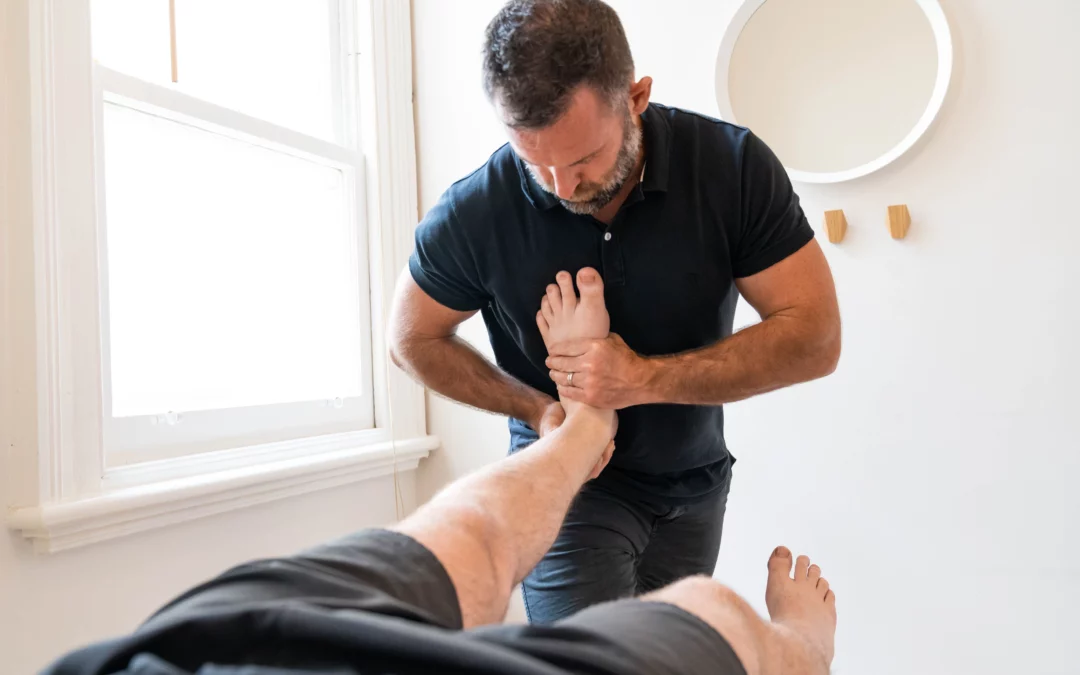Can Osteopathy Help Diagnose and Treat a Calf Strain?
Table of Contents
- Introduction
- Understanding Calf Strains 2.1 What Is a Grade 1 Calf Strain? 2.2 Signs and Symptoms 2.3 Causes and Risk Factors
- Osteopathic Assessment and Diagnosis
- Osteopathic Treatment for Calf Strains 4.1 Manual Therapy Techniques 4.2 Exercise-Based Rehabilitation 4.3 Return-to-Function Strengthening Plan
- Sample Rehab Program for a Grade 1 Calf Strain
- Why Choose Principle Four Osteopathy in Melbourne CBD?
- FAQs About Calf Strains and Osteopathy 7.1 Can I walk with a calf strain? 7.2 How long does a grade 1 strain take to heal? 7.3 Should I ice or heat a calf strain? 7.4 Do I need a scan?
- Author
Introduction
Calf strains are a common soft tissue injury affecting recreational and amateur athletes, walkers, runners, and workers alike. They typically involve overstretching or minor tearing of the calf muscles, especially the gastrocnemius and soleus.
At Principle Four Osteopathy in Melbourne CBD, our team uses evidence-informed assessment, hands-on care, and progressive rehabilitation to guide you from injury through to full recovery. Whether you’re getting back to sport or simply walking pain-free, we help you return safely and confidently.
Understanding Calf Strains
2.1 What Is a Grade 1 Calf Strain?
A Grade 1 strain is a mild injury involving micro-tearing of muscle fibres with minimal functional loss. It usually presents as tightness, mild discomfort, or stiffness but allows for weight bearing and light activity.
2.2 Signs and Symptoms
- Mild pain in the lower leg during or after activity
- Localised tenderness on touch
- Tightness or stiffness in the muscle
- No significant swelling or bruising
- Minimal loss of strength or function
2.3 Causes and Risk Factors
- Sudden push-off or sprinting motion
- Poor warm-up or flexibility
- Overtraining or fatigue
- Previous calf or Achilles injury
- Inadequate footwear or surface changes
Osteopathic Assessment and Diagnosis
Osteopaths are trained to clinically assess soft tissue injuries through history-taking, functional testing, and orthopaedic assessment.
At Principle Four Osteopathy, we:
- Identify the grade of strain
- Rule out referred pain from lumbar spine or nerve issues
- Assess joint mobility and surrounding muscle function
- Evaluate gait and movement patterns
Osteopathic Treatment for Calf Strains
4.1 Manual Therapy Techniques
To support early healing and reduce symptoms, we may use:
- Soft tissue massage to improve circulation
- Trigger point release to reduce muscle tightness
- Joint mobilisation for ankle and knee mechanics
- Dry needling where indicated
4.2 Exercise-Based Rehabilitation
Rehab is critical in avoiding re-injury. We design stage-based programs that progress from gentle mobility to functional strength:
- Early isometric calf holds
- Active range of motion exercises
- Gentle walking and heel raises
4.3 Return-to-Function Strengthening Plan
As symptoms resolve, our team integrates:
- Eccentric calf strengthening (e.g. slow heel drops)
- Single-leg balance and proprioception drills
- Plyometric and agility drills if needed
Sample Rehab Program for a Grade 1 Calf Strain
Week 1–2: Acute Phase
- Rest from aggravating activity
- Ice for pain (15–20 minutes, 2–3x/day)
- Gentle calf stretching (no pain)
- Isometric calf contractions (3 sets x 10 reps daily)
Week 3–4: Recovery Phase
- Standing double-leg heel raises (3 sets x 12 reps)
- Seated calf raises with light weight
- Begin short walks on flat ground
- Light foam rolling (if not painful)
Week 5–6: Return to Activity
- Single-leg heel raises (progressively weighted)
- Calf eccentric heel drops
- Skipping, light jogging, agility work
- Return-to-sport drills as tolerated
Why Choose Principle Four Osteopathy in Melbourne CBD?
Located at Level 4, 178 Collins Street, our clinic provides:
- Thorough injury assessment and rehab planning
- Access to gym-based exercise facilities
- Skilled osteopaths with sports and workplace rehab experience
- Hands-on care paired with functional recovery strategies
We tailor care for runners, workers, gym-goers and anyone aiming to move without pain.
FAQs About Calf Strains and Osteopathy
Can I walk with a calf strain?
Yes, if pain is mild. Avoid aggravating activities and see an osteopath for guidance.
How long does a grade 1 strain take to heal?
Typically 2–3 weeks with proper rest and rehab.
Should I ice or heat a calf strain?
Ice is preferred in the first 48–72 hours to reduce pain. Heat may help later to improve circulation.
Do I need a scan?
Not usually. Grade 1 strains are diagnosed clinically. Imaging is only needed for suspected rupture or persistent pain.
Author
Heath Williams
Principal Osteopath | Strength Coach | Rehab Specialist
Heath and the team at Principle Four Osteopathy support clients with calf strains through evidence-informed care, functional rehab and strength-based recovery programs in Melbourne CBD.
